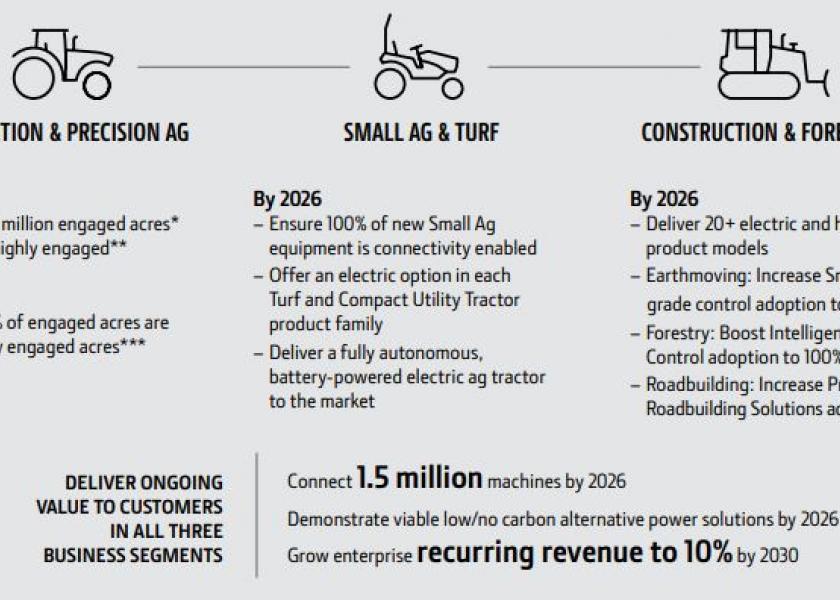John Deere Paves Its Sustainability Journey With Technology

For a second year, John Deere has released a sustainability report to highlight its milestones so far and state its goals for the future.
Deere CEO John May explains the company has launched its approach called Leap Ambitions to align business goals and sustainability goals. This is after the company reorganized with its Smart Industrial strategy which brought its business sectors closer to its customers.
“Quite frankly, introducing this amount of change during such a dynamic period, it felt risky at times. But I've come through it convinced more today than ever it was absolutely necessary to position our company, for the opportunity ahead of us, and energize our team to achieve new levels of performance,” May said during the company’s quarterly results call in February 2022.
The strategy is propelling the business to reach the sweet spot when sustainability, productivity, and profitability overlap for its business and the business of its customers.
For its production ag and precision ag business, John Deere is targeting measurable gains in how it can use technology to reach those sustainability goals.
Than Hartsock, Director, Corn & Soybean Production Systems at John Deere, says, “As we continue to bring technology based solutions to producers what's exciting about our part of the industry–production agriculture and precision agriculture–is there such strong alignment between the profitability of a farm and the sustainability of that farm as well. There’s overlap for the intersection of it's good for the farm, it's good for the good for the environment, and ultimately it's more profitable for the farmer at the end of the day.”
Hartsock outlines three ways John Deere thinks of sustainability in relation to its products:
- How the equipment is used in the field
- Contributions those machines can make toward sustainable outcomes
- How machinery and technology can be combined to help farmers on their trajectory of being stewards of the land.
In one year, the company increased the connected machines in its network by 100,000. And it upped ‘engaged acres’ by 80 million.
By 2026, the company wants to add another 185 million engaged acres.
Trajectory of Sustainabilty
To bring more effective technology to customers faster, in the past two years John Deere aligned its technology under one central Chief Technology Officer.
John Deere says it will make investments in four technologies to strengthen its capabilities in:
- Digitization
- Autonomy
- Automation
- Electrification
Tangible technologies include the full autonomous 8R and chisel plow pairing introduced in January 2022, and the forthcoming See & Spray Ultimate, which will provide in-season precision herbicide applications reducing the amount applied by more than two-thirds and saving more than $30 per acre and more than 2,300 gallons of contact herbicides per year. Also, at the beginning of 2022, John Deere announced its investment to become the majority owner of Krisel Electric—an Austrian battery company focused on high-density, rechargeable power units.
Two-pronged Deployment
John Deere will work to introduce new technologies as well as innovations that can be enabled on its existing equipment. Hartsock gives examples of machines being outfitted from the factory for technologies as well as performance upgrade packages such as are currently available for planters and sprayers.
“For dramatic adoption of precision ag solutions, it starts with value for the customer. And if that's not there, that we don't invest in it, and we don't have a product to sell,” he says.
Change to The Business Model
With more embedded technologies delivering value to customers, John Deere is starting to shifts its business model stating the goal of having 10% of revenues by 2030 be recurring revenue—or subscription based. Company officials say this aligns its business with the value customers realize in use of the equipment. And they give autonomy as an example.
“We've been working on autonomy for the last few years and always knew always knew it would offer significant customer value,” May said. “The response we got from our dealers and our customers was even greater than we imagined. The need for autonomy is here today. The demand for the solution is real.”
What’s To Come
“When I look ahead. I see a long and exciting runway of opportunity,” Hartsock says. “In the last year and a half we've made a double down commitment on the opportunity to bring technology and digital solutions integrated with the machines and the implements that do the work every pass across the field.”
He says we are on the cusp of managing every crop at the plant level and layering that with every pass every crop production cycle, the opportunity is growing, but time is imminent.
“Every season that we miss, in having the next generation See & Spray solution or the next generation automation or even the acres still today that maybe don't get the full benefit from section control or Exact Emerge, I would get these technologies to the acres as quickly as I possibly could,” he says.
John Deere’s Path To Greater Engagement
Hartsock says farmers can expect to see four things from John Deere in the next year and beyond.
- More local demonstrations of technologies and the value to farmers.
- Easier to use technologies
- Work toward greater connectivity and eliminating that as a hurdle to adoption
- Enablement for carbon markets and other emerging opportunities.
“We will continue to work to ultimately create solutions for farmers that make outcomes previously not possible,” he says. “With the problems we are trying to solve and the digital connectivity we are looking to provide, we are confident how valuable they can be to farmers on nearly every acre that gets farmed.”







